Blog: 5 ways to improve employee retention
Date 30.08.2018

Jane Partridge, Senior Lecturer in Human Resource Management at the University of Northampton, shares her views on the issue of employee retention – a major headache for companies and HR departments worldwide…
With ongoing costs rising and the average cost of recruiting an employee at £2,000 (CIPD 2017), retaining staff has never been such an important task. There are many ways to improve retention. One retention strategy relates to recruitment and selection.
‘Expectations are also often raised too high during the recruitment process, leading people to compete and subsequently accept jobs for which they are in reality unsuited’ (CIPD 2018).
Realistic job previews
Showing and telling prospective employee what the job is really, about. This could include a full explanation of the job role, the good and bad, during the interview. A through tour of the premises or even a work shadow. The long shifts, the demanding customers, the staff facilities, the people they will be working with. Often jobs in Boutique hotels are perceived as glamourous, as staying in Boutique hotel is a glamorous experience. The realities are the jobs are physically demanding and can be repetitive in nature. Using a realistic job preview, can reduce unrealistic expectations, which are often a reason for new employees to leave. This is especially important when recruiting potential candidates who have not worked in the hospitality industry or who have a minimal work experience.
Job criteria
Be clear about what you want! Sit down and think about the duties of the job and the knowledge and skills, the person needs to be able to perform the job successfully. If you are clear about these criteria, you can test them during your selection process.
Selection is not just about an interview
The most effective methods at predicting the effectiveness of a candidate are where multiple selection methods are used. You could create a job simulation activity, based on tasks which the candidate would perform in their job role. For example, dealing with a difficult customer, setting a cover, making a bed. If you have several candidates, host a mini assessment centre with a range of different tasks. With a work-based activity simulation, you would need to establish a grading system to grade the different standards for a success. You would need to think about using more than one assessor to ensure fairness.
The interview
Plan your questions based on the criteria from your job description and person specification. Using strength based interview techniques or competency interviewing can help.
Induction
A poor induction is one of the main reasons people leave, during the early stages of employment. An effective induction should include, information on performance standards, training on how the employee needs to perform, introduction to the team, support from a buddy/coach in the first 6 months, organisational language and routines, goals and values, legal requirement training. The CIPD and ACAS have great checklists to help plan an effective induction programme.
In the CIPD resourcing and talent management survey (2017), improving selection techniques and induction were rated as one the most effective retention methods. By implementing these different aspects, within your recruitment and selection processes, will help to retain your employees.
For more information Human Resource Management, please visit the course page.